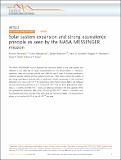Solar system expansion and strong equivalence principle as seen by the NASA MESSENGER mission
Author(s)
Mazarico, Erwan; Goossens, Sander; Lemoine, Frank G.; Neumann, Gregory A.; Genova, Antonio; Zuber, Maria; Smith, David Edmund; ... Show more Show less
Downloads41467-017-02558-1.pdf (681.1Kb)
PUBLISHER_CC
Publisher with Creative Commons License
Creative Commons Attribution
Terms of use
Metadata
Show full item recordAbstract
The NASA MESSENGER mission explored the innermost planet of the solar system and obtained a rich data set of range measurements for the determination of Mercury's ephemeris. Here we use these precise data collected over 7 years to estimate parameters related to general relativity and the evolution of the Sun. These results confirm the validity of the strong equivalence principle with a significantly refined uncertainty of the Nordtvedt parameter η = (-6.6 ± 7.2) × 10⁻⁵. By assuming a metric theory of gravitation, we retrieved the post-Newtonian parameter β = 1 + (-1.6 ± 1.8) × 10⁻⁵ and the Sun's gravitational oblateness, J₂⊙ = (2.246 ± 0.022) × 10⁻⁷. Finally, we obtain an estimate of the time variation of the Sun gravitational parameter, GM⊙/ GM⊙ = (-6.13 ± 1.47) × 10⁻¹⁴, which is consistent with the expected solar mass loss due to the solar wind and interior processes. This measurement allows us to constrain |G'|G to be < 4 × 10⁻¹⁴ per year.
Date issued
2018-01Department
Massachusetts Institute of Technology. Department of Earth, Atmospheric, and Planetary SciencesJournal
Nature Communications
Publisher
Nature Publishing Group
Citation
Genova, Antonio et al. “Solar System Expansion and Strong Equivalence Principle as Seen by the NASA MESSENGER Mission.” Nature Communications 9, 1 (January 2018): 289 © 2018 The Author(s)
Version: Final published version
ISSN
2041-1723